


|
THE TEMPLE OF PHILAE
This temple, dedicated to the goddess Isis, is built on an island of the First cataract on the old Nubian territory. Pierre Loti calls it "the pearl of Egypt". Champollion wrotes "Every thing is quite new, from the greco-roman period, except a small temple to Hathor and a propylon included in the first temple pylon.... which is the best". Philae is named by the Greeks Pi-Rek, pronounced by the Egyptians Pi-Lek meaning the Northern End of Nubia.
The sanctuary has a strong link with the "Holy island" of Bigeh consecrated to Osiris. Originally, it was separated from Philae by a narrow channel. The priests of Isis use to go to Bigeh to honour the murdered god. They make libations on the 365 offering tables which surround the god grave. Every ten days, the priesthood bears the Isis statue in order to offer some milk to Osiris.
The temples dedicated to the goddess seem to expand at the first millennium before our era. They are the Ptolemies who, associating the Egyptian goddess Isis to the Alexandrine Separis divinity, create some important religious centres. The Roman world carries out this cult. The temple of Isis at Sabratha (Libya) builds at the II Century A.D. is one of the best examples of the Isis veneration in the Mediterranean Basin.
From the higher Antiquity, the legend of Isis and Osiris seems to be strong in the Egyptian believes. We know the sad story about the King Osiris, called "Ounnefer": the everlasting good and perfect human being assassinated by Seth and cut in fourteen pieces. The virile member is thrown away in the Nile and eaten by the fish Oxyrrhinque. Isis, the Great Magician, rebuilds the body of her husband with the help of her sister Nephtys and the god Anubis. She changes herself into a small bird, goes over the body of her husband allowing him to fecundate her. The eternal good and perfect human being (the positive) remains then for ever.
It is possible that the cult of Isis has been yet in Philae island at the Middle Empire; some royal statues fragments have been found. Champollion uncovers a re-used block on which was written the name of Ahmosis, king of the XXVI dynasty. Nectanebo I, builds a kiosk for the Isis bark. Ptolemies I and II, erect and decorate the holy part of the temple oriented toward Nubia, where the flood is coming from. A ten columns pronaos is added to the sanctuary and closed by a pylon. Ptolemies III and IV build the mammisi (the birth-house). The last part is enlarged by Ptolemy VIII which orders a colonnade in the peristyle court. The entrance pylon dates probably from Ptolemy VI; his name is written on the West part of its passage. |
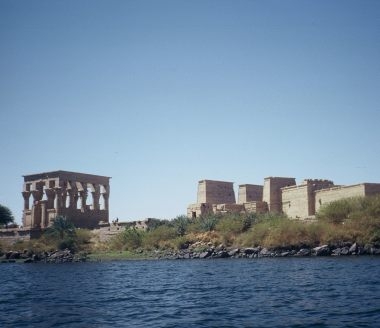 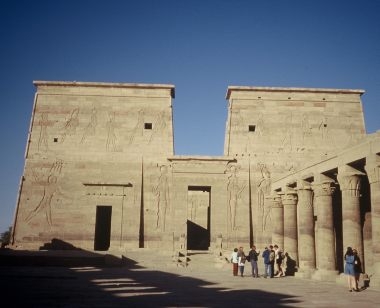 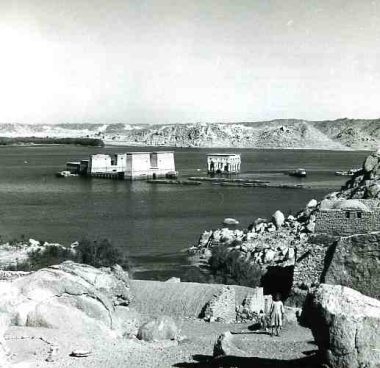 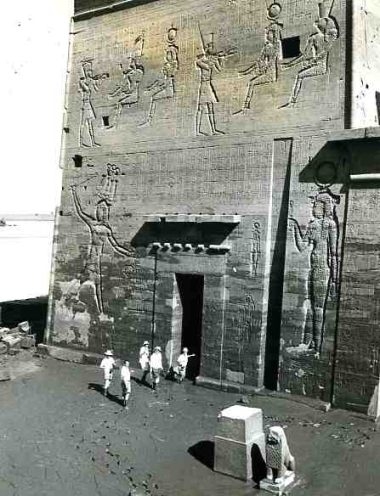 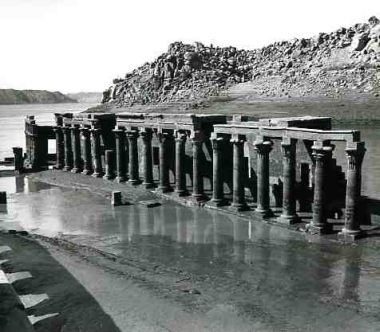 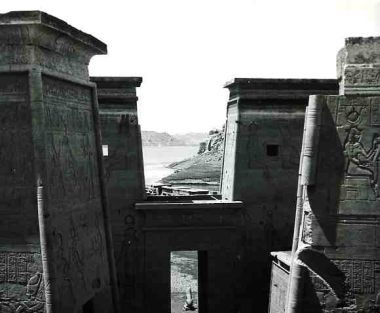 From Est, greco-roman temple of Philae in the small island of the rocks of the First Cataract. It was dedicated to the divinity Isis. On the first row, the Trajan's kiosk (IIe J.C.) / Vu de l'Est, le temple gréco-romain de Philae sur une île parmi les enrochements de la Première Cataracte. Il était consacré à la déesse Isis. En premier plan, le kiosque de Trajan (IIe siècle après J. C.) From the South, the colonnade of the first peristyle courtyard and the entrance pylon of the Philae temple / vue du Sud, la colonnade de la première cours péristyle et le pylône d'entrée du temple de Philae In May 1968, Unesco endorsed the decision taken by the United Arab Republic to dismantle and re-erect the monuments on the neighbouring island of Agilkia which was sufficiently elevated to be above the maximum level of the water. Easy to recognized the temple by itself and the Trajan's Kiosk (photo Unesco/ Alexis N. Vorontsoff 1972 / En mai 1968, l'Unesco s'associe à la décision prise par la République Arabe Unie de déplacer et de reconstruire les monuments du temple sur l'île voisine d'Agilkia, assez élevée pour se situer toujours au-dessus du niveau maximum des eaux. Il est aisé de reconnaître le temple et le kiosque de Trajan (photo Unesco/ Alexis N. Vorontsoff 1972) Pylon of the entrance of the Philae temple just out of the waters of the lake of the first dam of Assouan before the new flood. Some experts sent by Unesco study the salvage of the building (photo Unesco/ Laurenza 1959) / Pylône d'entrée du temple de Philae libéré des eaux du lac de retenue du premier barrage d'Assouan avant que ne survienne la nouvelle crue (photo Unesco/ Laurenza 1959) The colonnade of the first peristyle courtyard out of the waters of the flood of the Nile ( photo Unesco/Laurenza 1959) / La colonnade de la première cours péristyle libérée des eaux de l'inondation (photo Unesco/Laurenza 1959) The two first pylons seen from the North (photo Unesco/Albert Raccah) / Les deux premiers pylônes vus depuis le Nord (photo Unesco/Albert Raccah) |
|
At the South of the temple, a double portico adorns its Western and Eastern parts, with some spaces consecrated to the gods Arensnouphis, Mandoulis and the venerated Imhotep.
On the Eastern part, the Trajan’s kiosk and the small Hathor’s temple complete the religeous buildings. On the Northern part, the Augustus’ temple and the Diocletian’s door confirm the Roman domination.
Two churches attest of a Christian belief completing by the big hypostyle room fitted out for this cult.
However, thanks to the Blemmyes’ tribes, the temple of Philae is the last one to honour the cult of Isis goddess (until the VI Century A.D.).
The populations refuse the closing down of this Egyptian sanctuary after the Theodosia’s decree. But in 388, this emperor authorized them to adore Isis and to carry her statue to bless their land. Between 450 and 540, two cults exist on the same time, but the emperor Justinian stops definitively the Isiac veneration. The priests and the bishop Theodosia transform the temple into a church which is consecrated to San Esteban.
Thanks to the Nubian world, the Egyptian memory has been saved through the cult of Isis during the first centuries A.D. It’s only with Champollion that the Nilotic history reborns, proving the importance of the cultures and the civilizations which have marked the Nile Valley.
|
|
THE TEMPLE OF PHILAE
The sanctuary has a strong link with the "Holy island" of Bigeh consecrated to Osiris. Originally, it was separated from Philae by a narrow channel. The priests of Isis use to go to Bigeh to honour the murdered god. They make libations on the 365 offering tables which surround the god grave. Every ten days, the priesthood bears the Isis statue in order to offer some milk to Osiris.
The temples dedicated to the goddess seem to expand at the first millennium before our era. They are the Ptolemies who, associating the Egyptian goddess Isis to the Alexandrine Separis divinity, create some important religious centres. The Roman world carries out this cult. The temple of Isis at Sabratha (Libya) builds at the II Century A.D. is one of the best examples of the Isis veneration in the Mediterranean Basin.
From the higher Antiquity, the legend of Isis and Osiris seems to be strong in the Egyptian believes. We know the sad story about the King Osiris, called "Ounnefer": the everlasting good and perfect human being assassinated by Seth and cut in fourteen pieces. The virile member is thrown away in the Nile and eaten by the fish Oxyrrhinque. Isis, the Great Magician, rebuilds the body of her husband with the help of her sister Nephtys and the god Anubis. She changes herself into a small bird, goes over the body of her husband allowing him to fecundate her. The eternal good and perfect human being (the positive) remains then for ever.
It is possible that the cult of Isis has been yet in Philae island at the Middle Empire; some royal statues fragments have been found. Champollion uncovers a re-used block on which was written the name of Ahmosis, king of the XXVI dynasty. Nectanebo I, builds a kiosk for the Isis bark. Ptolemies I and II, erect and decorate the holy part of the temple oriented toward Nubia, where the flood is coming from. A ten columns pronaos is added to the sanctuary and closed by a pylon. Ptolemies III and IV build the mammisi (the birth-house). The last part is enlarged by Ptolemy VIII which orders a colonnade in the peristyle court. The entrance pylon dates probably from Ptolemy VI; his name is written on the West part of its passage.